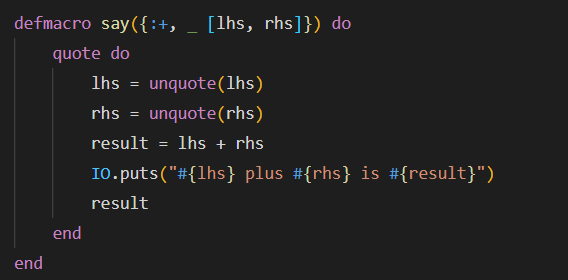
Chapter 1 of Metaprogramming Elixir, Write Less Code, Get More Done (and Have Fun!) by @chris_mccord
You can get your copy here:
pragprog.com/titles/cmelixi…
Twitter summaries are back! 🧵
#myelixirstatus #elixirnewbie.
0/17
You can get your copy here:
pragprog.com/titles/cmelixi…
Twitter summaries are back! 🧵
#myelixirstatus #elixirnewbie.
0/17
Ever dream of having that one cool feature in your language of choice? With luck, you might see it in a few years, more likely never. However, Elixir is different. Through metaprogramming, Elixir allows you to extend the language and create first-class features.
1/17
1/17
Most programming languages have an AST (Abstract Syntax Tree), but it's hidden from you. When compiled or interpreted, the program's source code is transformed into a tree structure before being turned into bytecode or machine code.
2/17
2/17
@josevalim, the creator of Elixir, chose to expose the AST and provide a natural syntax for interacting with it. Now as an Elixir developer, you have the power to operate on a level usually reserved for compilers and language designers.
3/17
3/17
Metaprogramming revolves around inspecting and manipulating the AST. For example, the Logger module in Elixir optimizes performance by removing expressions from the AST. Most languages would instead waste resources checking ignored logger levels.
4/17
4/17
Rather than work with the AST directly, Elixir provides macros to empower you to work with the AST with natural Elixir syntax and constructs.
Macros receive ASTs as arguments and return ASTs as values. Macros are essentially code that generates code.
5/17
Macros receive ASTs as arguments and return ASTs as values. Macros are essentially code that generates code.
5/17
Macros allow you to pattern match on the AST structure passed into it.
defmacro add({:+, _, [lhs, rhs]})
6/17
defmacro add({:+, _, [lhs, rhs]})
6/17
the quote macro allows you to return an AST. the unquote macro allows values to be injected into the AST that's being defined. It's like string interpolation for code. You use it whenever evaluating a passed argument.
7/17
7/17
Putting that all together, here's an example macro that matches on a simple 2 term addition statement.
8/17
8/17

Within a module, macros can have multiple function signatures. So in the example above, you could also implement a `say` macro for multiplication.
9/17
9/17
There are two rules for writing macros. 1. Don't write them 2. Write them gratuitously. Keep this duality in mind as you explore macros. Many have been bitten by reckless complexity, but you must also avoid letting pitfalls scare you away from the power of macros.
10/17
10/17
Every expression in Elixir breaks down to a three-element tuple in the AST. {atom, metadata, arguments}. The AST forms trees of functions and arguments.
11/17
11/17
For example, in your iex shell you can run
quote do: 2 + 2
> {:+, [context: Elixir, import: Kernel], [2, 2]}
quote do: 2 + 2 + 2
{:+, _, [{:+, _, [2, 2]}, 2]}
I've simplified metadata [context: Elixir, import Kernel] to _ for the sake of readability.
12/17
quote do: 2 + 2
> {:+, [context: Elixir, import: Kernel], [2, 2]}
quote do: 2 + 2 + 2
{:+, _, [{:+, _, [2, 2]}, 2]}
I've simplified metadata [context: Elixir, import Kernel] to _ for the sake of readability.
12/17
In macro expansion, the compiler encounters a macro and then expands it. if the expanded code also contains macros it then expands those. This expansion occurs recursively until all macros have been expanded into fully generated code.
13/17
13/17
Macros inject code for the caller. The place where the code is injected is called a context. A context is the scope of the caller's bindings, imports, and aliases. If you lose track of your macro's execution context, it's a sign your code generation may be too complex.
14/17
14/17
Macro hygiene protects the caller's context. Variables, imports, and aliases that you define in a Macro do not bleed into the caller's own definitions.
15/17
15/17
You can use the var! macro to explicitly allows the macro to override hygiene and produce AST that has the caller's bindings. var! can be a necessary evil but should be avoided when possible.
16/17
16/17
I hope you enjoyed today's summary! I'm happy to be back and doing these again. I've been prioritizing work on the upcoming #elixirnewbie website, but I hope to be back to doing these daily :)
17/17
17/17
• • •
Missing some Tweet in this thread? You can try to
force a refresh



